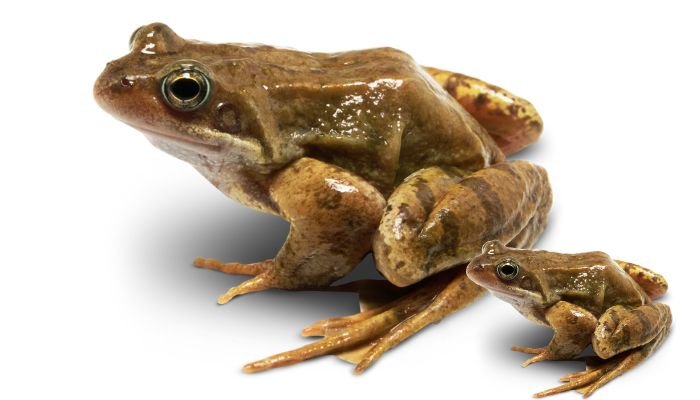From its crystal-clear lakes and lush woods to its abundant wildlife, Ontario, Canada is a country of natural delights. Frogs are some of the most beloved residents in this province. These little amphibians are not only fascinating to see but also important in gauging the state of Ontario’s ecosystems. In this article, we will give information about “Types of Frogs in Ontario”, with their habitat, and physical characteristics.
How Many Types of Frogs in Ontario?
Read below How many Types of Frogs in Ontario:-
I. Wood Frog (Lithobates sylvaticus)
One of the most common frogs in Ontario is the Wood Frog, or Lithobates sylvaticus. The dark mask-like pattern around the eyes of these tiny terrestrial frogs is what gives them their characteristic appearance; it is reminiscent of a raccoon’s face. Wood frogs are common in the province’s woodlands, ponds, and mixed forests.
Physical Characteristics:
- The average adult is only 5–7.5 cm in length.
- They have a brown or reddish brown upper body and a white underbelly.
- Their distinctive quacking cries set them apart from other duck species during mating season.
Habitat: Forest frogs typically lay their eggs in vernal pools or other wetlands in damp forests. For breeding and tadpole development, these short-term wetlands are essential.
The presence of wood frogs is taken as an ecological sign of a well-maintained forest. Because of their sensitivity to environmental changes and pollutants, their presence or absence can provide insight into the state of the ecosystem as a whole.
II. Spring Peeper (Pseudacris crucifer)
The Spring Peeper, or Pseudacris crucifer, is another well-known species of frog in the province of Ontario. The springtime air is filled with the distinctive chorus of these little frogs, who live in trees.
Physical Characteristics:
- Adults are usually between 2.5 and 3.8 centimeters in length.
- Their body is a dark or grayish brown color, and they have a large X-shaped mark on their back.
Habitat: The Spring Peeper’s varied habitat preferences allow it to thrive in a wide range of environments. During the breeding season, they tend to congregate in trees and bushes.
Ecological Significance: These frogs are an integral part of the ecosystems of Ontario because of the function they play in regulating insect populations. Their raucous song heralds the approach of spring.

III. American Bullfrog (Lithobates catesbeianus)
One of the largest frog species in Ontario is the American Bullfrog, or Lithobates catesbeianus by its scientific name. These hardy frogs are found all throughout the world and have a characteristic deep call.
Physical Characteristics:
- Adults can grow to a maximum of 20 centimeters in length.
- Appearance-wise, they are greenish-brown overall with a white underbelly and muscular, bulky thighs.
Habitat: The American bullfrog is highly adaptable, and its aquatic habitats span from ponds and lakes to marshes and slow-moving rivers.
Ecological Significance: Ecologically, they are significant because they help regulate insect populations and are a vital link in the food chain, despite being ferocious predators that can harm local amphibians and small animals.
IV. Northern Leopard Frog (Lithobates pipiens)
Lithobates pipiens, sometimes known as the Northern Leopard Frog, is a species of frog native to Ontario that is both beautiful and well-known. Their vivid coloring and pronounced markings set them apart from any other frog species in the region.
Physical Characteristics:
- The length of an adult is between 6 and 11 centimeters.
- Their body is either green or brown, and they have striking black spots all over, much like a leopard.
Habitat: Common habitats for Northern Leopard Frogs include ponds, lakeshores, marshes, and slow-moving streams and rivers.
Ecological Significance: These toads play important roles in wetland food webs as both predators and prey. They eat insects and provide food for many different kinds of fauna.
V. Mink Frog (Lithobates septentrionalis)
The Mink Frog, or Lithobates septentrionalis as its scientific name suggests, is a rare and obscure species of frog found only in Ontario. Their name comes from their odor, which is sometimes compared to that of a mink.
Physical Characteristics:
- The average adult is just about 5–7.5 cm in length.
- Their bodies might be green or brown, and they have dark patches and a pronounced ridge that runs down their back.
Habitat: The northern portions of Ontario are home to Mink Frogs, and they prefer a habitat of forested areas with clear, cold water bodies like lakes and ponds.
Ecological Significance: These frogs play a crucial role in the food web and nutrient cycling of the northern aquatic ecosystem.
VI. Pickerel Frog (Lithobates palustris)
Lithobates palustris, more often known as the Pickerel Frog, is a beautiful species of frog native to Ontario. They got their name because their bodies look like the pickerel fish.
Physical Characteristics:
- The average adult is just about 5–7.5 cm in length.
- They have conspicuous rectangular dots throughout their back and legs against a light brown or yellow background.
Habitat: Pike-Perch Habitat Typical habitats for frogs include wetlands, streams, and ponds that are shallow and move slowly.
Ecological Significance: Ecologically, these frogs are significant because they are sensitive markers of marsh health. When they are present, it may indicate that aquatic ecosystems are healthy as a whole. Are you interested to read about:- Do Frogs Have Buttholes?
Facts
[table id=24 /]
Conclusion
A Summary of Types of Frogs in Ontario
The many varieties of frogs found in Ontario are not only fascinating to see, but also essential to the health of local ecosystems. Each species of frog, from the nocturnal Wood Frog to the vocal Spring Peeper, is important in its own way to the ecosystem.
We must value and safeguard these amphibians and their habitats if we are to fulfill our responsibility as environmental stewards. Doing so safeguards the natural environment of Ontario and the continuation of their wonderful singing. In this article, we have given information about “Types of Frogs in Ontario”, with their habitat, and physical characteristics.

